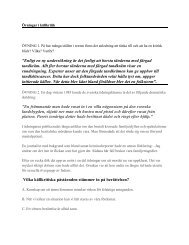From a cognitive perspective, this paper ... - Lunds universitet
From a cognitive perspective, this paper ... - Lunds universitet
From a cognitive perspective, this paper ... - Lunds universitet
Create successful ePaper yourself
Turn your PDF publications into a flip-book with our unique Google optimized e-Paper software.
Cognition, multimodal interaction<br />
and new media 1<br />
Jana Holsanova 2<br />
Cognitive Science Dept., Lund University<br />
jana.holsanova@lucs.lu.se<br />
ABSTRACT: <strong>From</strong> a <strong>cognitive</strong> <strong>perspective</strong>, <strong>this</strong> <strong>paper</strong> summarises a<br />
number of theoretical and applied studies conducted by my colleagues and<br />
myself on the topic 'interaction with new media'. The focus lies on the<br />
users' behaviour: visual information gathering, interaction with the<br />
multimodal interface, browsing strategies and attentional processes during<br />
hypertext navigation. In addition, we also look at users' expectations and<br />
attitudes towards the medium. There are several methods that can be used<br />
in order to describe user behaviour and postulate a number of underlying<br />
<strong>cognitive</strong> mechanisms. In the following, I will show how eye-tracking data<br />
supplemented by simultaneous or retrospective verbal protocols, keystroke<br />
logging, and interviews can help us to investigate users' behaviour, the<br />
1<br />
The <strong>paper</strong> is based on my presentation “Tracking multimodal interaction<br />
with new media” at the workshop on The citizens use and comprehension<br />
of information on the Internet arranged by Kerstin Severinson Eklundh and<br />
Britt-Louise Gunnarsson, Uppsala 18-19 June 2004.<br />
2<br />
Vsechno nejlepsí, Wlodku, k narozeninám a díky za vsechny spolecné<br />
diskuze a rozhovory. - Dziękuję bardzo. Z pozdrowieniami, Jana.<br />
Printed from: Hommage à Wlodek. Philosophical Papers Dedicated to Wlodek Rabinowicz. Ed. T. Rønnow-Rasmussen, B. Petersson,<br />
J. Josefsson & D. Egonsson, 2007. www.fil.lu.se/hommageawlodek<br />
1
ationality behind <strong>this</strong> behaviour, and users' attitudes and expectations. The<br />
clusters and integration patterns discovered in empirical studies can be used<br />
in developing a new generation of multimodal interactive systems within<br />
human-computer interaction.<br />
User Behaviour on the Internet<br />
The first study conducted in 1996 by David de Léon and myself was a<br />
qualitative study of user behaviour on the World Wide Web concerning<br />
hypertext navigation and browsing strategies. Eight participants were<br />
filmed while performing user-defined tasks and then asked to review the<br />
video-taped session during prompted recall. This data formed the basis for<br />
a series of descriptions of user behaviour and the postulation of a number of<br />
underlying <strong>cognitive</strong> mechanisms. Our results indicate that users lack ready<br />
made search strategies, prefer alternatives that are visible, immediately<br />
available and familiar, choose the path of least resistance, exhibit social<br />
forms of behaviour, engage in parallel activities, object to misleadingly<br />
presented information, have trouble orienting, are late in using appropriate<br />
strategies, are sensitive to matters of time, and are emotionally involved in<br />
the activity. Finally, we discuss how these results can contribute to our<br />
understanding of hypermedia (for details see de Léon & Holsanova 1997;<br />
<strong>this</strong> <strong>paper</strong> - as well as most of the following <strong>paper</strong>s mentioned - can be<br />
downloaded in PDF format at http://lucs.lu.se/jana.holsanova).<br />
Eye Movements and Attention<br />
In the following studies, we wanted to follow visual scanning and<br />
attentional processes more exactly and thus started using an eye tracker.<br />
2
The motivation of eye movements is to bring to a particular portion of the<br />
visible field into high resolution so that we can see it in fine detail. When<br />
we focus our concentration and eye movements on a point, we also divert<br />
our attention to that point. Data on visual behaviour can thus be used as<br />
measures of <strong>cognitive</strong> processes. Eye tracking allows us to register<br />
precisely what is fixated and when. We can follow along the path of<br />
attention deployed by the observers and get insights into what the observers<br />
found interesting, what drew their attention, how a scene was perceived etc.<br />
Picture Viewing and Picture Description<br />
In my dissertation (Holsanova 2001), I investigated visual scanning and<br />
simultaneous verbal description of complex scenes. The goal was to<br />
compare the contents of verbal and visual 'attentional spotlight' and to<br />
answer the following questions: Can we identify comparable units in visual<br />
perception and in language production? Does the order of units in the<br />
verbal description reflect the general order in which information was<br />
acquired visually? Is the content of the units in picture viewing and picture<br />
description similar? In order to synchronise the verbal and the visual<br />
streams, I created an analytic format called multimodal time-coded score<br />
sheets. With the help of <strong>this</strong> new analytic format, I could analyse temporal<br />
and semantic relations between speech and gaze and extract configurations<br />
of verbal and visual clusters from the synchronized data. (Concerning the<br />
results of my studies, see Holsanova 2006 or consult<br />
http://lucs.lu.se/jana.holsanova). The method combining eye tracking and<br />
verbal protocols in order to get an enhanced picture of attentional processes<br />
3
has been further developed in our recent study (see The dynamics of<br />
perception and production during text-writing).<br />
Picture Viewing and Mental Imagery<br />
It has been proposed that we use mental imagery when we mentally invent<br />
or recreate personal experience, when we read novels, plan future events,<br />
retrieve information about the physical properties and relations of objects,<br />
imagine transformations by mental rotation and mental animation and when<br />
we solve problems. Finke (1989:2) defines mental imagery as “the mental<br />
invention or recreation of an experience that in at least some respects<br />
resembles the experience of actually perceiving an object or an event, either<br />
in conjunction with, or in the absence of, direct sensory stimulation.” A<br />
large number of eye tracking studies have been conducted to test mental<br />
imagery. In order to extend the finding of previous studies, we chose<br />
pictures of high complexity as our visual stimulus and conducted a number<br />
of new eye tracking studies (Johansson, Holsanova and Holmqvist 2005,<br />
2006). Our data indicate that even for a complex picture, spatial locations<br />
are to a high degree preserved when describing it from memory. Our results<br />
suggest that subjects visualize the spatial configuration of the scene as a<br />
support for their descriptions from memory. The effect we measured is<br />
strong. The results can be interpreted as further evidence that eye<br />
movements play a functional role in visual mental imagery and that eye<br />
movements indeed are stored as spatial indexes that are used to arrange the<br />
different parts correctly when a mental image is generated. However, there<br />
are alternative interpretations: According to an ’embodied view’, subjects<br />
leave behind ‘deictic pointers’ to locations of the scene in the environment,<br />
4
which later may be perceptually accessed when they are needed. According<br />
to the ‘perceptual activity theory’ account, imagery is the re-enactment of<br />
the specific exploratory perceptual behaviour that would be appropriate for<br />
exploring the imagined object as if it were actually present.<br />
News<strong>paper</strong> and Net Paper Reading<br />
Eye tracking has also been used in applied studies of readers' interaction<br />
with news<strong>paper</strong> and net <strong>paper</strong> layout. For designers, the most interesting<br />
issues are entry points (where do the readers start reading?), reading paths<br />
(how do the readers navigate through the medium?), reading depth (how<br />
carefully do they read the articles?) and local design factors (the effect of<br />
colour, pictures, headlines, drop quotes etc.). Two behaviours can be<br />
distinguished: the reading behaviour (a well defined movements across the<br />
text) and the scanning behaviours (large saccades in almost any direction<br />
when the reader is evaluating articles: are they worthy of deeper<br />
processing?). We conducted several applied studies on news<strong>paper</strong> and net<br />
<strong>paper</strong> reading (see references) but apart from the issues mentioned above,<br />
we also wanted to understand some of the underlying rationale and<br />
motivation of the behaviour. We were interested in readers' reflections,<br />
experiences, comments and attitudes towards the new medium. To achieve<br />
<strong>this</strong> aim, we used a combination of three methods: (i) eye tracking, (ii)<br />
retrospective verbal protocols supported by the replay of the interaction and<br />
(iii) interview data.<br />
Let us review some of the main questions and answers. How do readers<br />
interact with net <strong>paper</strong>s compared to news<strong>paper</strong>s? Does the new medium<br />
5
influence our way of searching for news? How do readers orient, navigate,<br />
which reading paths and entry point do they choose? What are their<br />
attitudes towards the medium? Our results show that in fact net <strong>paper</strong><br />
readers scan more and read less than news<strong>paper</strong> readers. We furthermore<br />
investigate whether <strong>this</strong> result can be explained by the difference in layout,<br />
navigation structure and purpose of reading between the two media.<br />
The reading and interaction patterns in the two media differed. Net <strong>paper</strong><br />
readers seemed to have problems with orientation in the hyper-structure.<br />
Below are some of the comments that the participants made on their<br />
interaction which could be used as explanations of the patterns found on the<br />
basis of eye tracking.<br />
Reading situation, purpose of reading<br />
“I just have a quick look at the net <strong>paper</strong> during a break to see what has<br />
happened.”<br />
“It's a nice relaxation to spend time reading a news<strong>paper</strong> over a cup of<br />
coffee.”<br />
Navigation<br />
”I start from the first page to get an overview, but I have problems getting<br />
back.”<br />
Entry points<br />
”I think it’s difficult to decide whether to enter an article on the basis of the<br />
headline only. It easily happens that you misunderstand it.”<br />
”The content links were messy and it took some time to scan them through<br />
in order to find what to read.”<br />
Topic spectrum<br />
6
”I think net <strong>paper</strong>s are good because it is easy to compare different news<br />
sources and how they report about the same news.”<br />
The reading situation and purpose of reading vary a lot between the<br />
different media. The comments on navigation confirmed the patterns in<br />
reading paths - net <strong>paper</strong> readers have difficulties orienting and navigating.<br />
In addition, switching to another story is very slow in net <strong>paper</strong> reading<br />
compared to news<strong>paper</strong> reading. While it takes only 20-50 ms to move the<br />
eyes to another article on the news<strong>paper</strong> fold, for net <strong>paper</strong> readers it takes<br />
much longer. They have to determine which article they want to read by<br />
reading content summary (link), they have to click on the link and wait for<br />
the article page to be downloaded. The feed back is very slow. Since the<br />
investment of switching story is such a high threshold, the readers rather<br />
avoid switching between stories. Once they decided to read a story, they<br />
read it to the end. To sum up, news<strong>paper</strong> reading is characterised by a<br />
broad topic spectrum and shallow reading. Net <strong>paper</strong> reading, on the other<br />
hand, is characterised by a narrow topic spectrum and deep reading. For<br />
more results consult e.g. Holmqvist et al. (2003) and Holsanova &<br />
Holmqvist (2004).<br />
Discussing Theoretical Frameworks<br />
Researchers within the sociosemiotic framework have suggested how a<br />
news<strong>paper</strong> layout could be analysed (Kress & van Leeuwen 1996). This<br />
analytical framework has also been applied for the Internet (cf. Karlsson &<br />
Ledin, 2000). In one of our studies, we decided to extract hypotheses about<br />
reading of news<strong>paper</strong> layout from Kress & van Leuwen’s work and<br />
discussed them in connection to data from readers' authentic interaction<br />
7
with a news<strong>paper</strong>. In particular, we used eye tracking to empirically test<br />
hypotheses about entry points and reading paths. First, news<strong>paper</strong> layout<br />
was analysed according to the sociosemiotic approach (without any<br />
knowledge of the actual reading behaviour). Second, eye movement data on<br />
the news<strong>paper</strong> fold was analysed in three different ways: i) the temporal<br />
order of the attended areas was calculated in order to determine reading<br />
priorities; ii) the amount of time spent on different areas was calculated in<br />
order to determine which areas have been read most; iii) finally, reading<br />
depth was calculated in order to determine how carefully those areas have<br />
been read. The results show that the reading behaviour is very dynamic.<br />
Readers register the units predicted by the sociosemiotic theory but the<br />
reading paths are created in very different ways (cf. Holsanova, Rahm &<br />
Holmqvist 2003, 2006).<br />
Dynamics of Perception and Production in On-line Text Writing<br />
The process of visual information gathering and on-line text production<br />
was studied in a current project in co-operation between researchers from<br />
the Cognitive Science Dept. and Linguistics Dept. at Lund University<br />
(project leaders: Sven Strömqvist and Kenneth Holmqvist). Our project<br />
team collected data from 96 participants (balanced for age, gender and<br />
dyslectics/controls) and used an extended methodology: production-rate<br />
data from key-stroke logging (ScriptLog), eye-tracking data (iView) and<br />
follow up debriefing interviews supported by the playback of the<br />
interaction. For analysing the interaction between writing and gaze<br />
behaviour, we have developed an analytical tool (Andersson et al., 2006),<br />
inspired by the multimodal time-coded score sheets developed by<br />
8
Holsanova (2001). The tool helps with analysing temporal and semantic<br />
synchrony in picture viewing and picture description. This offers an<br />
enhanced picture of the attentional processes: which objects or areas were<br />
scanned visually and which objects or areas were described verbally at a<br />
certain point of time. When investigating picture descriptions, we can see<br />
how the writers' attention is distributed between the stimulus picture,<br />
keyboard, computer monitor and elsewhere during writing. In sum, <strong>this</strong><br />
analytic format gives deeper insights into the dynamics of perception and<br />
production during on-line text writing.<br />
Integration and Interpretation of Text and Pictures<br />
Multimodality has been studied within many different disciplines:<br />
semiotics, sociosemiotics, textlinguistics, interface design, and humancomputer<br />
interaction (cf. Holsanova 1996, for an overview, cf. Holsanova<br />
1999, 2002). However, very few studies concern the way users perceive the<br />
interplay between the modalities: <strong>From</strong> which source do users' acquire<br />
information and how do they integrate it? Some first steps have been<br />
carried out with reading of diagrams and within applied studies of<br />
advertisements (Rayner et al. 2001). The process of semantic interpretation<br />
during picture-elicited writing will also be an important contribution to <strong>this</strong><br />
topic (Holsanova 2003). To sum up, perception and interpretation of<br />
multimodality is strongly understudied and deserves more extensive focus<br />
in future research.<br />
9
Reading Information Graphics<br />
A couple of recent studies at the Humanist Laboratory in Lund are devoted<br />
to the reading of information graphics. The reading paths between headline,<br />
text and infographics can give us hints about the integration and<br />
interpretation processes. The choice of entry points can tell us more about<br />
the readers’ interests and the process of meaning-making. In one of our<br />
studies, we address the issue of whether the overall design of information<br />
graphics influences reading behaviour (Holmqvist et al. 2006, Holsanova et<br />
al., 2006. forthc.). Our second study focuses on factors that have effects on<br />
the comprehension of information graphics (Holmberg et al. 2006). The<br />
studies are relevant for the research on <strong>cognitive</strong> processes involved in<br />
multimodal integration, for the applications in printed and digital media<br />
and for the design of user-friendly multimodal documents. Currently, we<br />
are investigating the integration of text, pictures and graphics within the<br />
project “Information Graphics and Eye Movements. Tracking reader's<br />
interaction with a multimodal document genre”, financed by the Helge<br />
Ax:sson Johnsson Foundation (project leader: Jana Holsanova, in<br />
cooperation with Nils Holmberg and Kenneth Holmqvist).<br />
Summary and Conclusions<br />
Gaze behaviour reveals the path through the text, paths through the picture<br />
and the connections created between picture and text. It can be used to<br />
track attentional processes. If eye-tracking data is supplemented by<br />
simultaneous or retrospective verbal protocols, the analysis can give a very<br />
detailed view on reader interaction with the media. By combining various<br />
methods, such as eye tracking, keystroke logging, retrospective verbal<br />
10
protocol supported by the replay of the interaction, and interviews, we<br />
obtain multiple 'windows into thought and action'. We can track users'<br />
navigation and orientation, detect interaction problems, evaluate interface<br />
design, test theoretical models against empirical results, investigate the<br />
perception of multimodality. It allows us to investigate user behaviour, the<br />
rationality behind the behaviour, and users' expectations and attitudes.<br />
Visions<br />
One of the visions is to investigate individual ‘reading styles’ – a question<br />
that is currently studied within the project “Reading paths and reading<br />
styles on a news<strong>paper</strong> spread” 3 at the Humanist laboratory at Lund<br />
University (project leader: Kenneth Holmqvist, in cooperation with Nils<br />
Holmberg, Henrik Rahm and Jana Holsanova). Another vision is to answer<br />
questions concerning cultural differences in reading text, pictures and<br />
graphics. Cognitive aspects of multimedia have been focused by Mayer<br />
(2005) and others. The connection between <strong>cognitive</strong> and cultural aspects<br />
has, however, not yet been addressed. A third vision is to track natural<br />
integration of different modes of communication (speaking, pointing,<br />
scanning pictures, writing text, etc.). When we have two or more<br />
continuous streams of behaviour, what does the semantic unification<br />
process look like? Where and when do we integrate those streams? Are<br />
3<br />
”Läsvägar och lässätt på tidningsuppslaget – ett tvärvetenskapligt projekt<br />
med semiotiska analyser och ögonrörelsemätningar”, financed by Erik-<br />
Philip Sörensens stiftelse.<br />
11
they overlapping or sequential? Which are the meaningful units of our<br />
interaction? Oviatt (1999) stresses the need of guidance from <strong>cognitive</strong><br />
science on co-ordinated patterns of human perception and production based<br />
on empirical evidence. The clusters and integration patterns discovered in<br />
such kind of empirical studies could be used in developing a new<br />
generation of multimodal interactive systems in human-computer<br />
interaction.<br />
References<br />
Andersson, B., Dahl, J., Holmqvist, K., Holsanova, J., Johansson, V.,<br />
Karlsson, H., Strömqvist, S., Tufvesson, S., and Wengelin, Å.<br />
(2006): Combining keystroke logging with eye tracking. In: Luuk<br />
Van Waes, Marielle Leiten & Chris Neuwirth (eds.)Writing and<br />
Digital Media, Elsevier BV (North Holland), 166-172.<br />
de Léon, D. & Holsanova, J. (1997). Revealing user behaviour on the<br />
world-wide web. Lund University Cognitive Studies 60. Lund<br />
university.<br />
Finke, R.A. (1989). Principles of Mental Imagery, Cambridge, MA: MIT<br />
Press.<br />
Holmqvist, K., Holmberg, N., Holsanova, J., Tärning, J. & Engwall,<br />
B. (2006): Reading Information Graphics - Eyetracking studies<br />
with Experimental Conditions (J. Errea, ed.) Malofiej Yearbook of<br />
Infographics, Society for News Design (SND-E). Navarra<br />
University, Pamplona, Spain, 54-61.<br />
Holmqvist, K., Holsanova, J., Barthelson, M. & Lundqvist, D.<br />
(2003): Reading or scanning? A study of news<strong>paper</strong> and net <strong>paper</strong><br />
reading. In Hyönä, J. R., and Deubel, H. (Eds.), The mind's eye:<br />
<strong>cognitive</strong> and applied aspects of eye movement research (657-<br />
670). Elsevier Science Ltd.<br />
Holsanova, J. (2004): Tracking everyday cognition. Invited lecture at<br />
KVIT 2004, Linköping, 6-7 May 2004.<br />
12
Holsanova, J. & Holmqvist, K. (2004): Med blick pa nätnyheter.<br />
Ögonrörelsestudier av läsning i nätbaserade tidningar. (Looking at<br />
the net news. Eye tracking study of net <strong>paper</strong> reading) In:<br />
Holmberg, Claes-Göran & Svensson, Jan (red.), Mediekulturer,<br />
Hybrider och Förvandlingar. Carlsson förlag, 216-248.<br />
Holsanova, J. (1996). När säger en bild mer än tusen ord? Om<br />
samspelet mellan text och bild i gränssnitt. In: Löwgren, J. (red.)<br />
Teman i människa-datorinteraktion. 65 -76. Institution för<br />
Informatik, <strong>Lunds</strong> <strong>universitet</strong>.<br />
Holsanova, J. (1999). Olika perspektiv pa språk, bild och deras<br />
samspel. Metodologiska reflexioner. (Different <strong>perspective</strong>s on<br />
multimodality. Methodological considerations) In: Inger Haskå &<br />
Carin Sandqvist (eds.): Alla tiders språk. Lundastudier i nordisk<br />
språkvetenskap A 55. (117-126). Lund University Press, Lund.<br />
Holsanova, J. (1999). På tal om bilder. Om fokusering av<br />
uppmärksamhet i och strukturering av talad beskrivande diskurs.<br />
(Speaking of pictures. Focusing attention and structuring spoken<br />
descriptive discourse in monological and dialogical settings).<br />
Licentiate dissertation. Lund University Cognitive Studies 78.<br />
Holsanova, J. (2001): Picture Viewing and Picture Description: Two<br />
Windows on the Mind. Doctoral dissertation. Lund University<br />
Cognitive Studies 83.<br />
Holsanova, J. (2006): Dynamics of picture viewing and picture<br />
description. In: Albertazzi L. (ed.), Visual thought. The depictive<br />
space of the mind. Part Three: Bridging perception and depiction<br />
of visual spaces. Advances in Consciousness Research.<br />
Benjamins, 233-254.<br />
Holsanova, J. (under utg.): Användares interaktion med multimodala<br />
dokument. I: Gunnarsson, B.-L. & Karlsson, A.-M. (utg.) Ett<br />
vidgat textbegrepp. TeFa rapport. Stockholms <strong>universitet</strong>.<br />
Holsanova, J., Rahm, H. & Holmqvist, K. (2003): Tidningarna och<br />
läsbarheten. I: Grammatik i fokus, volym I. Festskrift för Christer<br />
Platzack, 55-66. Institutionen för nordiska sprak, <strong>Lunds</strong><br />
<strong>universitet</strong>.<br />
Johansson, R., Holsanova, J. & Holmqvist, K. (2005): What Do Eye<br />
Movements Reveal About Mental Imagery? Evidence <strong>From</strong> Visual<br />
13
And Verbal Elicitations. In Bara, B. G., Barsalou, L., Bucciarelli,<br />
M. (Eds.), Proceedings of the 27th Annual Conference of the<br />
Cognitive Science Society, 1054-1059. Mahwah, NJ: Erlbaum.<br />
Johansson, R., Holsanova, J. & Holmqvist, K. (2006): Pictures and<br />
spoken descriptions elicit similar eye movements during mental<br />
imagery, both in light and in complete darkness. Cognitive Science<br />
30:6, 1-27. Lawrence Erlbaum.<br />
Karlsson, Anna-Malin & Per Ledin (2000): Cyber, hyper och multi.<br />
Några reflektioner kring IT-ålderns textbegrepp. Human IT. URL:<br />
http://www.hb.se/bhs/ith/23-00/amk.htm<br />
Kress, G. & T. Van Leeuwen (1996): Reading Images. The grammar<br />
of visual design. London & New York: Routledge.<br />
Mayer, R. (2005): Cognitive Theory of Multimedia Learning.<br />
Cambridge University Press.<br />
Oviatt, S. L. (1999): Ten Myths of Multimodal Interaction.<br />
Communications of the ACM, Vol. 42, No. 11, Nov. 99, 74-81.<br />
Rayner , K. , Rotello, C.M., Stewart, A, J,, Keir, J. & Duffy, S.A.<br />
(2001): Integrating text and pictorial information: Eye movements<br />
when looking at print advertisements. Paper at the ECEM in<br />
Turku.<br />
14



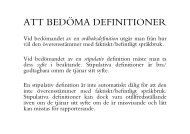
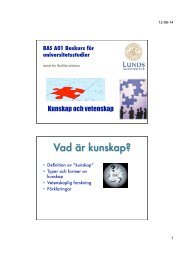
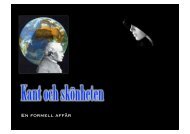
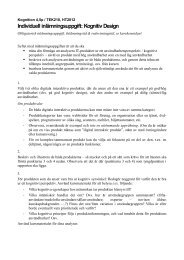
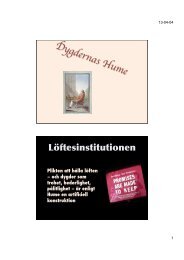
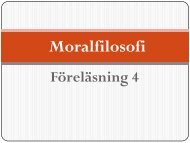

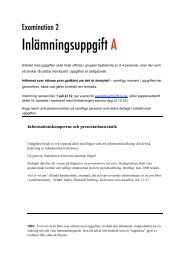
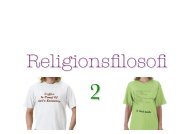
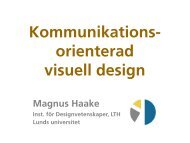
![Föreläsning2[1] (PDF 4.3 MB - New window) - Lunds universitet](https://img.yumpu.com/13992863/1/190x143/forelasning21-pdf-43-mb-new-window-lunds-universitet.jpg?quality=85)
